Maureen Van Nostrand, a sixth generation Irish Hill resident and descendant of Thomas Guiton painted this bucolic view (top) of the Curley, Conboy and Guiton farms on Irish Hill as they appear from St. John’s Cemetery. She was told that the Irish favored the area because it reminded them of the green rolling hills of Ireland. Her father, Jerry Guiton (not pictured), believes that the most distant hills are as far away as Towanda in Bradford County. Tom and Bob Curley (above) both reside in this 1904 farmhouse that has always been in their family. The house and farm can also be seen nearly at the center of Norstrand’s painting.
Story and above photo by Rick Hiduk
(originally published in the Susquehanna County Independent)
While a Google internet search provided no leads into the history of the Irish Hill area of northwest Susquehanna County, inquiries about Irish Hill on Facebook brought an almost immediate response. Three names quickly rose to the top: Curley, Guiton and Conboy. It should have been no surprise then that, as I drove up Irish Hill Road from Rush Township into Middletown Township, that three dirt roads connecting to the hardtop at the crest of the hill were Curley, Conboy and Guiton roads in that order.
When driving into this quiet, now largely wooded land, it’s hard to imagine hundreds, if not more than a thousand Irish immigrants and their descendants filling the farm fields of the gently rolling terrain. But Irish Hill was a mecca for early Irish Catholic settlers that endured as a thriving community that exists to this day, albeit on a smaller scale.
There are many other Irish names associated with area, but the aforementioned were inextricably bound forever as they intermarried and worked the land together. The farming life was not easy, but these people found a joy that can still be heard in the laughter of those sharing stories of simpler times.
Brothers Tom, 87, and Bob Curley, 82, still inhabit their childhood home on Guiton Road. They are two of six sons born to Francis and Bridget Curley, who also had a daughter named Mary Louise (Keenan). The older brothers were William, Richard, James, and Harold. James and Harold have passed away.
The house and barn were built in 1904 after the original farm house burned down. The interior of the house is modestly decorated and looks and feels very much like many of us who grew up in rural Pennsylvania would recall of our grandparents’ or great-grandparents’ homes. Once the storytelling begins, it’s very easy to feel that you’re literally being drawn back in time.
Bob maintains a very good copy of the original deed that shows that the farm was purchased in 1838 from the estate of Robert Rose, who had died a few years prior, leaving holdings to much of that part of the county to his heirs. This included Middletown Center, Friendsville, Choconut, St. Joseph’s, Silver Lake and Little Meadows.
Mary Louise is celebrated as a key historian of the Curleys and other families who intercepted these villages over the years, having written The Curley Book, which was last updated in 1999. The Curley’s American story begins with James Curley, who visited the area with his son, Thomas, a few years prior to bringing the rest of the family from Ireland to Pennsylvania.
Thomas stayed behind to build a log cabin for the arrival of his four brothers, three sisters, and father. His mother, Catherine, never made the trip, having passed away in 1837. Leaving Tipperary on June 15, 1841, the rest of the family would arrive in Middletown Township on August 15 of that year, having spent two months on ships, river and canal boats, and wagons.
In the introduction of the book, Mary (seated, above) ponders what brought so many Irish to America decades before the famous potato blight and Great Famine. But in fact, waves of Irish had been coming to the colonies since the 1500s and would represent 50 percent of all immigrants by the mid 1800s.
James Curley was Francis Curley’s great-grandfather, making Richard, Tom, Bob and Mary Louise the fifth generation of his family in America. According to Bob’s son, Matt, there are three generations beyond them. Tom and Bob remember their own grandfather, Martin Curley, fondly, as he lived with them on the farm until he died at the age of 98.
“When I got big enough that I should have been milking cows, I wasn’t as good at it as my other brothers or parents. I stayed at the house and washed the dishes while my grandfather dried them,” Tom recalls of Martin. “Whenever I goofed up and didn’t get one clean, he’d hand it back to me and say, ‘You should have gotten it right the first time.’ That stuck with me.”
The Guitons arrived in Susquehanna County prior to the Curleys, with Thomas Guiton, also from Tipperary, settling in Silver Lake Township in 1834. His son, Thomas, married Mary Curley, daughter of James Curley’s son, Martin, in 1884 and moved to Irish Hill after their first three children died of diphtheria.
Thomas Guiton and Mary Curley Guiton (above, seated) with their family in a 1930s photo.
Bridget Curley’s sister, Anna McKerney, married Francis Guiton, father of Jerry Guiton, a lifelong friend of Francis and Bridget’s children. With the duplication of first and last names so prevalent in these recorded histories, it became apparent to me that connecting all the dots for a newspaper story would be nearly impossible.
“Everyone on Irish Hill is related,” said Jackie Guiton, Jerry’s wife. Though she is married into the Guiton family, she became an Irish Hill historian by default. “The reason that I decided to get involved was because, in Jerry’s family, they are all related and I couldn’t tell them apart.
Tom Curley remembers his friend Jerry Guiton as a gifted writer who penned stories of family life that mirrored that of the Curley household. Those stories no doubt helped Jerry’s wife, Jackie, in her efforts to keep the family history alive. It was with their help and the interview with Tom and Bob, that I was able to put together this story.
In addition to the Conboys, who were among Tom’s and Bob’s first cousins, Jerry jotted down no less than 26 other surnames of people who were part of the community included on a 1872 map of Irish Hill on which Irish Hill Road was still called Wolf Road. Then he composed a shorter list of names of families who had married into the area afterward.
“The Irish Hill families were faithful Catholics,” Jackie related. “Their churches were St. John’s, St. Patrick’s, and St. Frances Xavier in Friendsville.” The Curleys attended St. Francis Xavier (now St. Brigid Parish.)
Jerry’s family attended St. John’s until it burned down in 1947, after which they attended St. Patrick’s at the end of Curley Road. Both are mission churches of the Parish of St. Francis Xavier in Friendsville.
The Curleys, Conboys and Guitons attended a two-room schoolhouse situated at the corner of Guiton and Irish Hill roads, across from St. John’s Cemetery, which Jerry Guiton maintained for many years. Jerry also guided the recovery in 2012 of St. John’s 1909 church bell, which had been buried with the rest of the charred remains of the church. The bell was rededicated in 2013 and is housed in a small structure (below) in the cemetery.
The Curley farmstead was typical of most in the area, with livestock ranging from chicken and pigs to sheep and cows, and fields full of fodder crops that would keep the animals fed during the winter months. Bob noted that his grandfather also maintained 30 colonies of honey bees and sold the extra honey.
“And there was an apple orchard on every farm,” said Tom.
Francis Curley put aside enough cash to purchase a new thrasher and a silo loader and helped farmers from Little Meadows to Rush and Lawton. “Not too long before he died, he told me, ‘I never got paid for a lot of that,’ but I’ll bet he went right back the next year and did it again,” Tom recalls. “Everybody helped each other.”
Neighbor Jim Golden (left) helps (continuing from left) Harold, Francis, and Bill Curley unload grain from a truck to a grainery in the 1950s.
The men remember Francis as a fun-loving sort. “He made sure that everyone had a good time when they were here,” said Bob. Though his brand of discipline was not over-handed, “he let you know if you were getting out of line.”
When they were younger, the Curley’s mail was left in a box at the end of Conboy road, and the children were sent by their parents to retrieve it. “They would tell us to come right home, but we’d get to playing with our cousins and forget.” Tom got up from the kitchen table as he told the story and retrieved an old leather shaving strap from an adjacent room. “They’d paddle us with this strap,” he recalled with a laugh. “It must not have hurt because we’d go back and do it the next day.”
A photo from 1947 shows (front, from left) Harold Curley, Jerry Guiton, Ed Conboy, (center) Bill Conboy, Bill Curley, Frank Murphy, (back) Joe, Ed, Jerry and Frank Conboy, and Ray Guiton on one of the family’s farm on Irish Hill.
Bridget Curley made sure that everyone was fed. “We had a lot of cousins besides the ones who lived here. They would often visit on Sunday’s around suppertime,” Tom reminisced. “Mother would tell us to go to the barn and do our chores and then come back to eat. They’d eat our dinner, and she’d make us another one.” Bridget never complained about it.
For a while, the family had two phones on opposite kitchen walls. “One went to Montrose. The other was a crank phone that went to the Guitons down the road,” Tom related. “Their relatives from New York and elsewhere would call us to pass along messages to them, and we’d walk back and forth across the kitchen to complete the calls.”
At a time when not much was known or said about learning disorders, it was apparent that their brother Harold’s approach to life was simpler than that of his siblings. He worked alongside his family members, though the tasks given to him were uncomplicated. “You couldn’t have him drive a tractor,” Bob recalled with a smile, “because if he saw a deer, he’d drive right off the road.”
Nonetheless, Tom remarked, Harold was perhaps the most loved Curley member of his generation. “Everybody who ever met him was attracted to him. They felt sorry for him and maybe realized how much better off they had it.”
“There wasn’t a kid that grew up on this hill that wasn’t better off for having met him,” said Bob. “They came to a better understanding of what it was like to be handicapped.”
Above, from left, Jim, Bob, Harold, Tom and Dick Curley on the farm in 2018.
Tom worked on the farm for about 13 years when he started buying equipment to start his own business, first cutting down locust trees and processing them as fence posts. “I liked working in the woods, and I still do,” he remarked. He later invested in bulldozers and did excavating work for a number of years. Tom served as a Middletown Township supervisor for about 20 years, starting in the 1980s, retiring after mowing roadsides and banks for a number of years.
Bob worked with numerous farmers in Susquehanna and northeastern Bradford County to fit and show cattle for sales. As he turned his attention full-time back to the family farm, he married Mary Crowley of Silver Lake. They had nine children.
“It was a good life. You were your own boss when you got up in the morning,” Bob stated. “When you got the chores done, you could go hunting or whatever you wanted to do.” he admits that he always looked forward to spring. “Winter was always tough. We had to get the milk truck in and out – have both the milk and the roadway ready. I liked Spring, because winter was behind you.”
“We always had lots of good food to eat. We’d pick blackberries and raspberries that Mother would can,” said Tom. “We didn’t have to worry about whether or not there was going to be dessert. I thank the Lord for that.” In the fall, they would slaughter pigs, chickens and an occasional cow in addition to shooting five or six deer, a task in which Mary Louise also participated.
“Music was important too. Many played fiddles, and there was always a piano in each house,” Jackie Guiton remarked. “Parties and celebrations were held in older times in their living rooms. They would roll up the rug and dance most of the night.”
I challenged Jackie to find a connecting point beyond friendship between the Conboys and the Guiton and, at first she didn’t believe their was one. After this story went to press, she reached out to me via email. “Jerry is related to the Conboys because Mae Curley married Leo Conboy,” Jackie explained. “They are third cousins to Jerry and his siblings. I’ve been doing geneology for 40-plus years, and I still get confused with all those cousins. It’s really hard to connect the dots.”
Most of the Guitons and Conboys have moved away from Irish Hill, but the Curleys continue to hold down the fort on Guiton Road, several generations living in adjacent homes and rightly proud of their Irish heritage and the good times they have had over many decades.
“We were probably better off than whatever else we could have been doing,” Tom says of life there.
“I wouldn’t have traded it for anything,” Bob agreed.
Photo by Rick Hiduk
The same view depicted in Maureen Van Nostrand’s painting as it appeared on March 11, 2022.
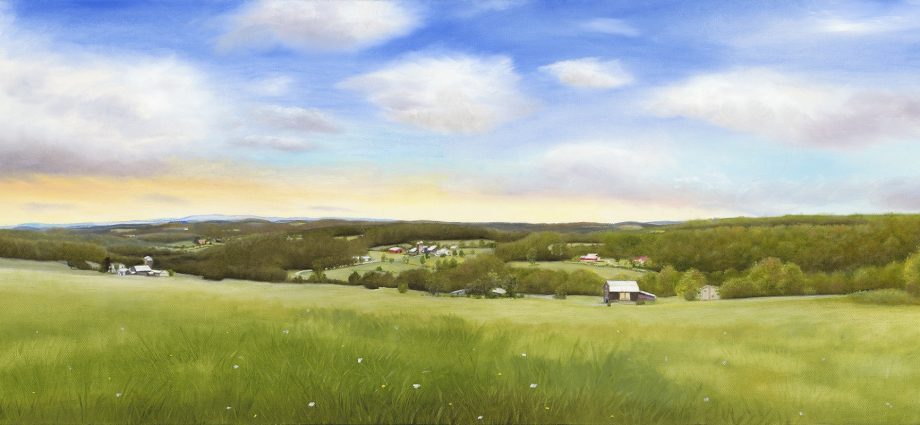
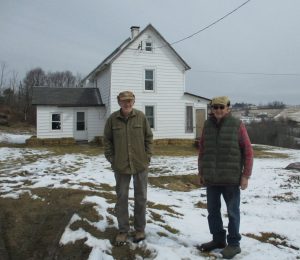
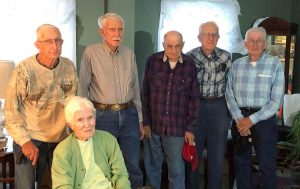
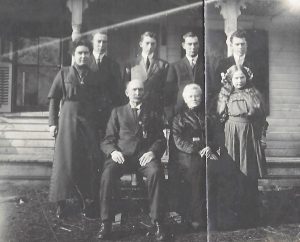
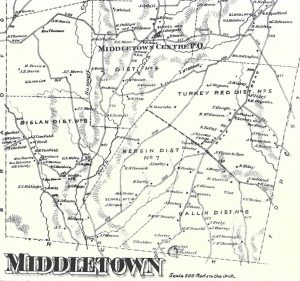
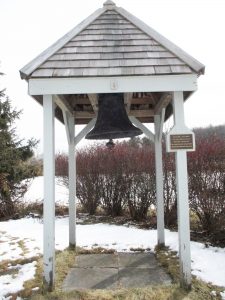
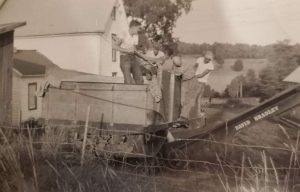
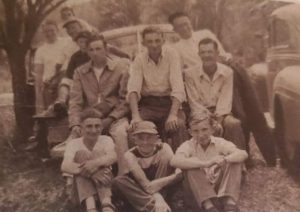
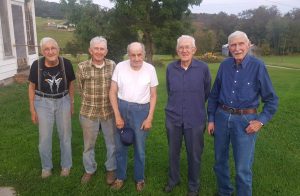
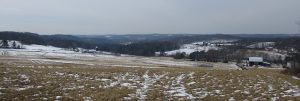
Great story!!!
Great article. Enjoyed it so much
Great reading, Rick. I always enjoy your community stories.